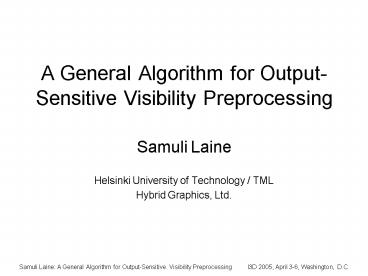A General Algorithm for OutputSensitive Visibility Preprocessing - PowerPoint PPT Presentation
Title:
A General Algorithm for OutputSensitive Visibility Preprocessing
Description:
Construct a hierarchy of viewcells. First compute VS of root cell ... Construct a dependence graph. Nodes are viewcells, edges are dependencies ... – PowerPoint PPT presentation
Number of Views:51
Avg rating:3.0/5.0
Title: A General Algorithm for OutputSensitive Visibility Preprocessing
1
A General Algorithm for Output-Sensitive
Visibility Preprocessing
- Samuli Laine
- Helsinki University of Technology / TML
- Hybrid Graphics, Ltd.
2
Visibility Preprocessing
- Goal avoid rendering hidden objects
- Utilize static occlusion
- Pre-process compute visible sets (VS)
- Divide accessible space into viewcells
- Find visible objects for each viewcell
- Run-time use VS
- Identify viewcell of the camera
- Draw objects in the VS of the viewcell
- Use VS of the viewcell as the PVS for the camera
3
Basic Properties of Visibility
- Sightlines are straight
- The VS of a viewcell is the union of
- Objects that overlap the viewcell
- Objects visible from the boundary of the viewcell
Object 1
Viewcell
Object 2
4
Computing the VS of a viewcell
- Rasterization Nirenstein Blake 2004
- Pick a viewpoint on the viewcells boundary
- Render the scene
- Add objects in the image to the VS of the cell
- Repeat until happy
- Exact Bittner 2002, Nirenstein et al. 2002
- Complicated, works in 6D dual space
- Slow
- Many conservative methods
5
What About Multiple Viewcells?
- Computing the VS of each viewcell separately is
inefficient - Does not utilize coherence of visibility
- Previous solution Hierarchical
refinementCohen-Or et al. 1998, Gotsman et al.
1999, Durand et al. 2000, Bittner 2002,
Nirenstein Blake 2004
6
Hierarchical Refinement
- Construct a hierarchy of viewcells
- First compute VS of root cell
- Split the cell into two child cells
- Recurse to the children
- Stop recursion when leaf cells ( final
viewcells) are reached
7
Hierarchical Refinement, contd
- The VS of parent cell bounds the VS of child cell
- Not visible to the parent cell ? not visible to
the child cell - Good hierarchical pruning of objects
- Bad still redundant work in internal cells
- We only need the VS of the leaf cells
- But we find the VS of the internal cells too
- Lets remove this redundancy
8
Removing the Hierarchy
- The parent cell is not the only possible source
for VS bounds - Idea use the VS of the neighbor cells
- Consider cell C and the set of its neighbors N
- Not visible to any N ? not visible to C either
- Except if inside C, which is a trivial case
- Cells must cover the entire world
- No hierarchy required
9
Removing the Hierarchy, contd
N1
N2
C
N4
N3
N5
- Major trouble nowhere to start!
- All cells depend on their neighbors
- Cyclic dependencies ?
10
Removing the Cyclic Dependencies
- Assumption viewcells are axis-aligned
- Lets constrain the sightline directions
- Divide direction space into 2dim partitions
- 4 quadrants in 2D
- 8 octants in 3D
- Define directed visible set (DVS) as the set of
objects visible to a viewcell, but with
constrained sightline directions - This is the key idea of the algorithm
11
Bounding the DVS
- Similar to bounding the VS with neighbors
- But now we may use only a subset of N
- Because we have constrained the sightline
directions - No more cyclic dependencies ?
- Except in funny situations, see paper
N1
N2
C
N3
12
Example Regular Grid
- Sightline directions constrained to top left
quadrant - Cell C depends on A and B
- Cell X depends on nothing ? start there
X
A
C
B
13
Ordering the Computation
- Construct a dependence graph
- Nodes are viewcells, edges are dependencies
- Edge from A to B, if A depends on B
- Sort the graph topologically
- Linear-time operation
- Always possible if the graph contains no cycles
- Process cells in sorted order ? can always get
DVS bounds
14
Dependence Graph Example
Cells and dependencies
Sorted dependence graph
15
The Full Algorithm
- For each quadrant / octant
- Construct dependence graph
- Process cells in sorted order
- For each cell
- Compute the bounds for DVS
- Call visibility solver with the bounds to obtain
DVS - Add objects in DVS to VS
16
Constraining the Visibility Solver
- Rasterization-based method
- Render images that correspond to casting rays to
the allowed directions
17
Experimental Results
- Synthetic scene
- Control over the amount of visibility
- Compare against hierarchical refinement
- With point caching Nirenstein Blake 2004
- Re-uses visibility samples taken at internal
cells - Use rasterization for solving the visibility
- Measure the average number of objects rasterized
by the visibility solver
18
Experimental Results Scenes
10 of tunnels open ? small visible sets
100 of tunnels open ? large visible sets
19
Experimental Results, contd
Improvement over hierarchical refinement
Average VS size, of objects
20
Summary
- Output-Sensitive
- The workload is only affected by the number of
visible objects - Proof in the paper
- No need to consider the entire scene at any time
- We always have a subset of objects to process
- Nice property if we have massive worlds
- Straightforward to implement
21
Thats It
- Questions
- Thanks
- Discussions Timo Aila, Lauri Savioja
- Funding National Technology Agency of Finland,
Bitboys, Hybrid Graphics, Nokia, Remedy
Entertainment































![Route Finding: A Quantum [Non] Algorithm PowerPoint PPT Presentation](https://s3.amazonaws.com/images.powershow.com/6836842.th0.jpg?_=20210507107)